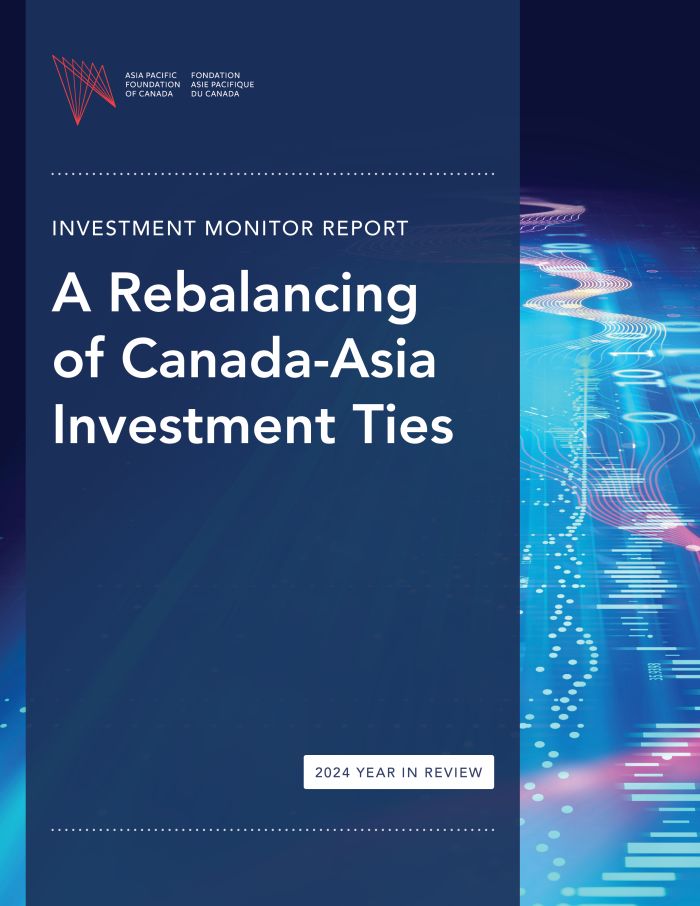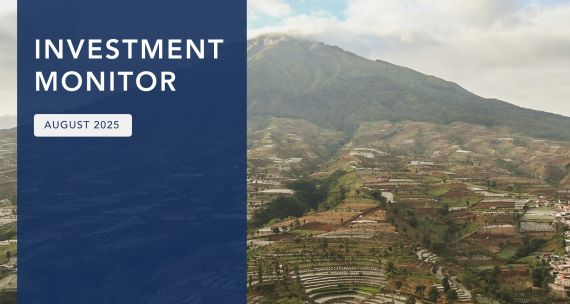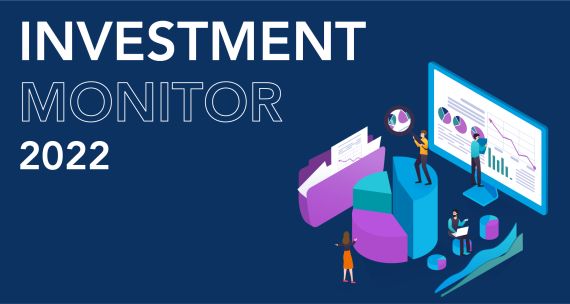Executive Summary
Canada saw a surge in total foreign direct investment (FDI) in 2024. According to Statistics Canada, the country’s total two-way investment flows rose from $190B in 2023 to $211B in 2024, an 11% increase, with the United States accounting for more than half of total flows. The U.S. and several European countries remain Canada’s top investment partners, together accounting for roughly 75% of total two-way FDI in 2024.
Turning to the Indo-Pacific, the region remains an increasingly important source and destination of FDI, with two-way investment flows last year valued at $24 billion – $19.2 billion inbound and $5.2 billion outbound.
APF Canada’s Investment Monitor data for 2024, however, shows a decline in total two-way FDI between Canada and the region, falling from $35B in 2023 to $24B last year. Between 2014 and 2023, Canada and the Indo-Pacific exchanged an average of $36B in FDI annually, underscoring the significance of the 2024 drop. That decrease was primarily driven by a sharp contraction in outward FDI, which fell by 57%, from about $12.2B in 2023 to $5.2B in 2024, a result of both emerging constraints and uncertainties in the region, and a shift in priorities among Canadian pension funds, a downward trend that began in 2021.
This decline in total two-way investment flows, however, masks an overall strengthening of Canada–Asia investment ties, driven by a steady rise in inward FDI over the past decade. Despite a 16% decrease in inward flows in 2024 (from $22.9B to $19.2B), Canada still received nearly 1.5 times more FDI from the Indo-Pacific than it did a decade ago, and 1.2 times more than the 10‑year average of C$17B, underscoring a long-term upward trend in inward investment.
Indeed, the Indo-Pacific now accounts for about one-quarter of all new FDI projects in Canada, with investment in 2024 mainly concentrated in Mining & Chemicals (46%), Industrial Goods & Services (41%), and Technology (8%). Together, these sectors reflect how Indo-Pacific investors are shifting their focus toward investing in high-value, innovation-led, and technology-driven Canadian industries.
Notably, the geography of Canadian investment in the Indo-Pacific is also shifting. Fifteen years ago, China and Hong Kong together accounted for an average of 23% of Canada’s FDI in the Indo-Pacific; today, that share has fallen to around 12%. India’s share, by contrast, has risen from 7% to an average of 23% today, reflecting a steady rebalancing of Canadian FDI. Investment in Australia, Japan, and South Korea, meanwhile, has declined only marginally, suggesting continued stability in Canada’s investment relationships with traditional partners.
In this context, APF Canada’s 2024 Investment Monitor Report, A Rebalancing of Canada-Asia Investment Ties, looks beyond official statistics to track the specific companies, sectors, and destinations driving Canada’s two-way investment flows with the Indo-Pacific, offering a more detailed and timely view of the trends, sectoral shifts, and partner-economy dynamics critical to Canada’s ability to deepen and diversify these investment relationships, which will be key to sustaining economic resilience and advancing the goals of Canada’s Indo-Pacific Strategy in the years ahead.
Key Takeaways
• Outward Flows
Canada’s two-way FDI flows with the Indo-Pacific declined sharply in 2024, driven by a steep drop in outward investment. Total FDI flows fell from $35B in 2023 to $24B in 2024 — well below the 10-year annual average of $36B. This 31% decline was largely the result of a sharp decrease in Canadian outward investment, which fell from C$12.2B in 2023 to C$5.2B in 2024, or 58%, due in part to lower pension fund activity. Outward FDI has now declined for three consecutive years, reflecting a broader rebalancing of Canadian investment.
• Inward Flows
Inward investment from the Indo-Pacific declined modestly but continues to follow a strong long-term growth trajectory. Inward FDI from the Indo-Pacific decreased from $22.9B in 2023 to $19.2B in 2024, or 16%. Despite this short-term slowdown, inward flows remain nearly 1.5 times higher than a decade ago, and above the 10-year annual average of $17B.
• Top Economies
Canada’s FDI with the Indo-Pacific is increasingly concentrated, with six economies accounting for nearly all investment flows. In 2024, 97.5% of Canada’s two-way FDI was with Australia (30%), Taiwan (22%), Japan (21%), China (15%), India (8%), and South Korea (1.5%). Outward FDI was the most concentrated, with Australia (55%), India (29%), and South Korea (6%) together representing 90% of total Canadian investment in the region. Inward FDI was dominated by Taiwan (28%), Japan (26%), and Australia (23%), which collectively accounted for nearly 80% of inflows.
• China and India
The geography of Canadian investment in the Indo-Pacific is shifting, with declining exposure to China and rising engagement with India. Fifteen years ago, China and Hong Kong together accounted for an average of 23% of Canada’s two-way FDI in the Indo-Pacific; over the last five years, their share has fallen to roughly 14%. By contrast, India’s share has climbed from 5% to an average of 26% over the last five years. Investment in Australia, Japan, and South Korea has remained comparatively stable, suggesting enduring confidence in Canada’s traditional Indo-Pacific partners even as the overall geographic distribution of FDI continues to evolve.
• Top Provinces
Indo-Pacific investment in Canada was highly concentrated in three provinces in 2024, with British Columbia, Quebec, and Ontario accounting for nearly 97% of total two-way FDI. B.C. led with $7.1B (37%) — driven by a surge in investment in critical minerals mining — while Quebec followed closely ($6.6B; 34%), largely due to Taiwan’s $5.2B acquisition of Future Electronics. Ontario’s share (26%) declined sharply, from $10B in 2023 to $5B in 2024, amid steep drops in finance and energy investment. All other provinces collectively attracted less than 3% of Indo-Pacific FDI inflows.
• Top Sectors
Indo-Pacific investment flows between Canada and the region in 2024 were highly concentrated in a few key sectors. On the inbound side, nearly 90% of FDI to Canada was directed to just two industries — Mining & Chemicals and Industrial Goods & Services — driven by major transactions in critical minerals and advanced manufacturing. Outward Canadian investment, while somewhat more diversified, was similarly focused, with close to 95% spread across six sectors, led by Consumer Goods & Services, Finance, and Mining & Chemicals. These patterns reveal a mutual concentration of investment in high-value, technology-intensive, and resource-linked sectors.
• Pension Fund Shifts
Canadian pension fund investment in the Indo-Pacific has declined sharply since its 2021 peak, as funds rebalance away from Asian emerging markets toward Europe and domestic assets. In 2024, pension funds accounted for 47% ($2.4B) of Canada’s outbound Indo-Pacific FDI — down 8% from 2023 and 90% since the peak in 2021 ($23B). After years of strong growth, pension funds have reduced exposure to most countries in the region, especially China, closed several regional offices, and redirected capital to Europe, where holdings (18%) now exceed their Indo‑Pacific allocations (13%).







